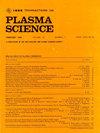Study of a 0.3-THz Extended Interaction Oscillator Based on the Pseudospark-Sourced Sheet Electron Beam
IF 1.3
4区 物理与天体物理
Q3 PHYSICS, FLUIDS & PLASMAS
引用次数: 0
Abstract
Our previous experimental study of a 0.2-THz extended interaction oscillator (EIO) driven by the pseudospark-sourced (PS) sheet electron beam has revealed one key issue: the discrepancy between the simulated and measured output power was dramatically large. Around this issue, the design and analysis of an improved 0.3-THz EIO are presented in this article. To make the prediction closer to the actual situation, a few factors, including the plasma effect, the ohmic loss caused by the surface roughness, the effective beam current, and the energy spread, are analyzed and considered in the simulations. The plasma is equivalent to a dielectric. To verify the design, the interaction circuit of the 0.3-THz EIO was microfabricated. Its RF performance was measured by using a vector network analyzer, which was in good agreement with the simulation prediction, and its surface roughness was measured by using an optical 3-D surface profiler. Beam–wave interaction simulations having considered the ohmic loss, energy spread, and plasma effect predicted that the upgraded EIO still could produce an output power of 16.3 W at 295.3 GHz.基于伪火花源电子束的0.3 thz扩展相互作用振荡器的研究
我们之前对假火花源电子束驱动的0.2太赫兹扩展相互作用振荡器(EIO)的实验研究揭示了一个关键问题:模拟输出功率与测量输出功率之间的差异非常大。围绕这一问题,本文设计并分析了一种改进的0.3 thz EIO。为了使预测更接近实际情况,在模拟中分析和考虑了等离子体效应、表面粗糙度引起的欧姆损耗、有效光束电流和能量扩散等因素。等离子体相当于电介质。为了验证设计的正确性,对0.3 thz EIO的交互电路进行了微加工。利用矢量网络分析仪对其射频性能进行了测量,结果与仿真预测吻合较好;利用光学三维表面轮廓仪对其表面粗糙度进行了测量。考虑欧姆损耗、能量扩散和等离子体效应的波束相互作用模拟预测,升级后的EIO在295.3 GHz下仍能产生16.3 W的输出功率。
本文章由计算机程序翻译,如有差异,请以英文原文为准。
求助全文
约1分钟内获得全文
求助全文
来源期刊

IEEE Transactions on Plasma Science
物理-物理:流体与等离子体
CiteScore
3.00
自引率
20.00%
发文量
538
审稿时长
3.8 months
期刊介绍:
The scope covers all aspects of the theory and application of plasma science. It includes the following areas: magnetohydrodynamics; thermionics and plasma diodes; basic plasma phenomena; gaseous electronics; microwave/plasma interaction; electron, ion, and plasma sources; space plasmas; intense electron and ion beams; laser-plasma interactions; plasma diagnostics; plasma chemistry and processing; solid-state plasmas; plasma heating; plasma for controlled fusion research; high energy density plasmas; industrial/commercial applications of plasma physics; plasma waves and instabilities; and high power microwave and submillimeter wave generation.
 求助内容:
求助内容: 应助结果提醒方式:
应助结果提醒方式:


